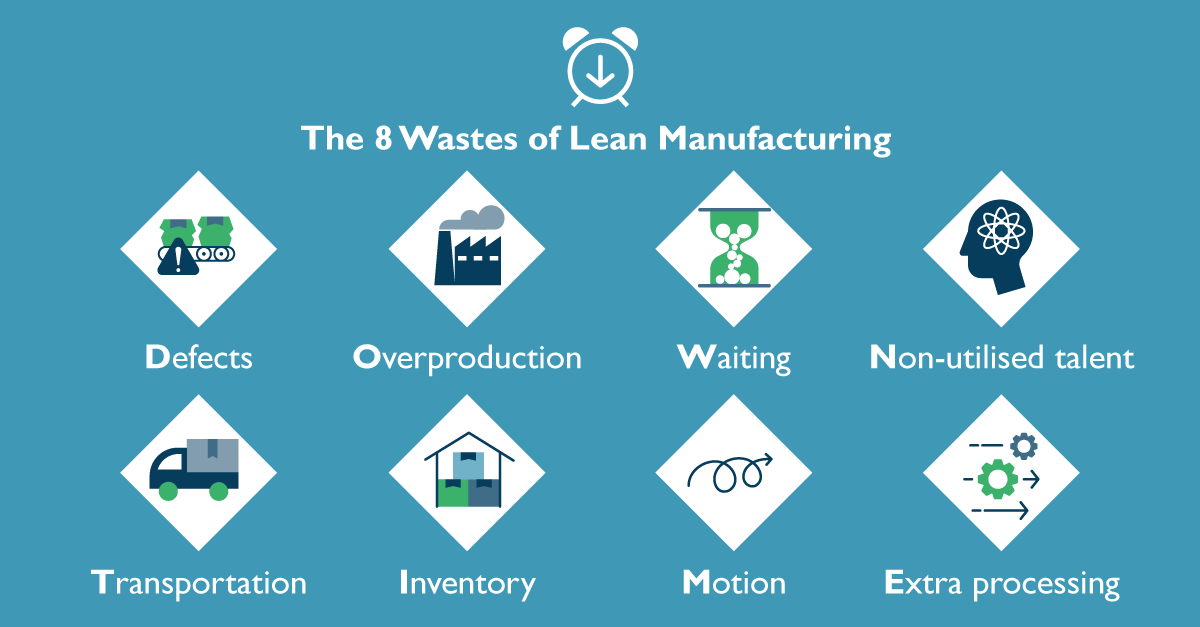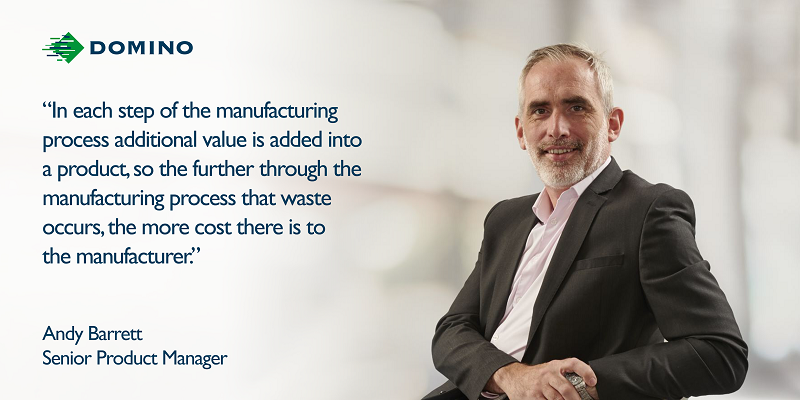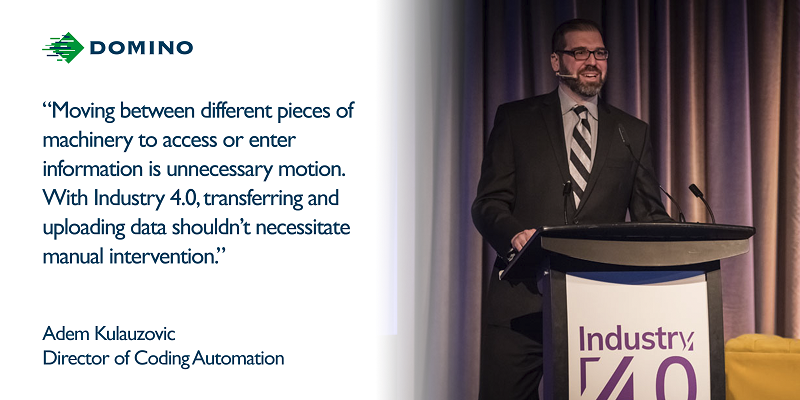Lean Manufacturing is far from a novel concept. Originating in the early automotive manufacturing systems of Henry Ford and later evolving into the Toyota Production System in the 1950s, the idea focuses on the value of minimizing unnecessary manufacturing waste to enhance efficiency and reduce costs.
However, significant changes have occurred over the past 70 years. For those manufacturers looking to incorporate Lean Manufacturing principles in the contemporary era, a new set of tools is available to facilitate the process – specifically, those provided by Industry 4.0.
This blog post will outline how manufacturers can integrate Lean Manufacturing with Industry 4.0, leveraging automation, integration, and cloud connectivity to diminish manufacturing waste and enhance productivity.
“As a manufacturer, Domino has a real understanding of the challenge facing our customers. In our award-winning manufacturing facility in Cambridge our customers can see a factory that embraces Lean Manufacturing principles and Industry 4.0 combining the virtues of a culture of continuous improvement, with Lean design assembly process, and a connected, data-driven factory.”Carl Haycock, UK Printer Operations Director at Domino.
The 8 Wastes of Lean Manufacturing

Lean Manufacturing identifies eight types of waste present in manufacturing operations:
- Defects
- Overproduction
- Waiting
- Non-Utilised Talent
- Transportation
- Inventory
- Motion
- Extra Processing
A Lean Manufacturing Model encourages the optimization of processes by eliminating these eight wastes, enabling manufacturers to concentrate on value-added production processes.
In the subsequent sections, we will delve into each of the eight wastes of Lean individually and consult with some of Domino’s experts in Industry 4.0 to explore how Domino’s products and solutions can assist manufacturers in their Lean Manufacturing endeavors.
“At Domino, we practice what we preach, which is why our systems, together with our culture, ensure our people are highly engaged in suggesting and implementing continuous improvement ideas instead of spending time on non-value adding tasks caused by poor system design and defects. All of this puts us in the front seat when designing our solutions to help today’s manufacturers to tackle the dreaded 8 wastes of Lean.”Carl Haycock, UK Printer Operations Director at Domino.
Defects
Incorrectly coded products pose a significant source of unnecessary manufacturing waste, incurring substantial costs for manufacturers to rectify.
Driven primarily by regulatory requirements, product coding and marking represent a crucial yet often overlooked step in manufacturing operations, and if neglected, they can become a major cause of defects.
“The earlier you capture waste, the cheaper it is to deal with,” states Andy Barrett, Senior Product Manager at Domino. “At each step of the manufacturing process, additional value is added to a product, so if waste occurs further along the process, the cost to the manufacturer increases – coding and marking is the final step in the process, so any waste is amplified.”
Errors in product coding encompass inaccuracies in the information printed on final products, issues with code quality (often stemming from errors elsewhere on the production line), resulting in illegible, incomplete, or missing codes, and inaccuracies in code placement, such as misaligned or misplaced codes.
Domino’s coding automation solutions aim to eliminate or significantly reduce the risk of incorrect codes by minimizing manual data entry. Through the utilization of coding automation software like QuickDesign, manufacturers can diminish the need for manual data entry by allowing printers to automatically populate label templates based on a central database or integrate with existing MES or ERP systems to create codes based on current production orders.
To further mitigate the risks of defects arising from incorrect codes, poor print quality, or misplaced/misaligned codes, implementing a code validation system is essential. Integrated cameras and vision inspection systems, such as Domino’s R-Series, can work alongside coding and marking systems to verify codes and automatically remove incorrectly coded items from the production line. These systems can also keep track of rejected codes, alerting a production manager when a specific threshold is reached. Additionally, if desired, systems can intervene and halt a production line until the issue is rectified.
Overproduction
Overproducing a product beyond the required amount for meeting production quotas can contribute to waste on production lines. The surplus production must be stored until it is utilised, leading to the need for warehouse space. This not only diminishes the available shelf life for the end consumer but, particularly with highly perishable items, also elevates the risk of products spoiling before they can be sold.
By eradicating defects in the production process, manufacturers can address one of the primary causes of overproduction – the lack of confidence.
Another scenario leading to overproduction is when a manual process is necessary to halt a production run – further details on this will be explored in the next section.
Waiting
Waiting for the completion of the preceding step in a process can significantly contribute to manufacturing waste. In industries with narrow profit margins, every second is crucial on busy manufacturing lines. Manufacturers relying on manual processes to halt production lines and initiate product changeovers are vulnerable to increased waste in the form of waiting.
Domino’s coding automation software, QuickDesign, can anticipate the required quantity of a product by utilizing information from production orders. It establishes an automatic product count linked to an alert system, notifying a system operator to initiate a stop as soon as the necessary production volume is attained.
This system also facilitates advance preparation for a product changeover by production staff, streamlining the changeover process and minimizing downtime between product runs.
“The waste of waiting can be closely linked to overproduction,” notes Kulauzovic. “Planning ahead to reduce line stoppages between products becomes impossible if the exact endpoint of a production run is uncertain.”
While manual operatives could be assigned to monitor printers and initiate stops to prevent overproduction, this approach is prone to human error and constitutes an inefficient use of personnel time.
Non-utilised talent
Automating routine tasks stands out as one of the most effective methods to liberate non-utilised talent on production lines. This ensures an engaged and optimised workforce, better equipped to foster a culture of continuous improvement in line with Lean Manufacturing principles.
“People often argue that automated systems eliminate jobs,” notes Kulauzovic. “In reality, this is not the case. With Industry 4.0, you are likely to start seeing more highly-skilled job roles emerging – providing opportunities for reskilling rather than job replacement.”
Training the new generation of manufacturing personnel is indeed a crucial aspect of Domino’s service offering. Alongside all of Domino’s products and solutions, a variety of tailored training courses are available to ensure that production personnel possess the requisite skills and knowledge to achieve the print quality, reliability, and efficiency demanded by modern production lines.

Transportation
Excessive transport, movement, and handling of items can significantly contribute to manufacturing waste, particularly in coding and marking where unnecessary transportation of products is often connected to product defects.
When a defect arises in the coding and marking of a product, the most favorable outcome is reworking, involving the unpackaging of the product and sending it back through the production line for reprocessing and repacking, incurring additional costs for the manufacturer.
“Unfortunately, in some industries, reworking defective products is not an option,” notes Barrett. “In the dairy industry, for example, where there is a high risk of spoilage and contamination, whole production orders may need to be scrapped in the event of a coding error.”
Dealing with product wastage of this nature often involves additional costs for the removal and proper disposal of wasted products, thereby introducing further waste in terms of transportation. Fortunately, manufacturers can easily prevent this type of transportation waste by ensuring that their coding and marking systems are optimised to avoid defects.
Inventory
Inefficient manufacturing processes inevitably result in surplus inventory, particularly in the form of excess product ingredients. Manufacturers engaging in regular overproduction find themselves compelled to maintain surplus stock to accommodate their excessive output.
“Holding excess stock to cater for overproduction is a vicious cycle, which is wasteful and highly inefficient in terms of cash flow,” remarks Barrett. “On food and beverage lines, manufacturers can also run the risk of products spoiling before they can be used.”
As previously highlighted, product defects, including coding errors, constitute the primary cause of overproduction. By utilizing QuickDesign to prevent defects, manufacturers can eliminate the need to retain excess ingredients. With a streamlined and automated production line, manufacturers only need to retain the stock necessary to fulfill production orders.
Motion
If transportation waste involves the needless movement of products, motion can be perceived as the unnecessary movement of people. Industry 4.0 has presented increased opportunities to minimize motion requirements more effectively than ever before.
“Production operatives moving between different pieces of machinery to access or enter information is unnecessary motion,” notes Kulauzovic. “With Industry 4.0, transferring and uploading data shouldn’t necessitate manual intervention.”
“In the past, when setting up printers for production runs, and adding, modifying, or creating labels, a person would have had to go around to every printer on a line and go through the process manually,” he elaborates. “With an automated coding solution from Domino, manufacturers can centralize all label management. A label is created or edited from the central control point, and when needed, it will be automatically sent to the required printer.”
Cloud communications can also be employed to eliminate unnecessary motion and offer a remote overview of different parts of a production line. Manufacturers utilizing the Domino Cloud, for instance, can access real-time information on printer performance and production metrics from any location worldwide.

Extra processing
Coding automation, as its name suggests, aids in eliminating extra processing waste by automating manual tasks and streamlining production processes.
Traditional manufacturing methods necessitate manual procedures to ensure that accurate data is generated and printed on the appropriate product. For instance, when generating a batch code, a production operative would typically follow a process to create and print the data correctly:
- Formulate the batch code using production order, date, location, etc.
- Input the code into the printer
- Inspect the final product to ensure the printed code is accurate and legible
With Industry 4.0, all these manual processes can be eradicated.
Automated coding solutions empower manufacturers to generate batch, product, and date codes, and fill label templates based on existing production orders. Concurrently, automatic vision systems can be employed to verify product information.
In this manner, the manual process of creating, entering, and checking codes can all be effectively eradicated.
Errors and inefficiencies in product coding can be a significant cause of excessive manufacturing waste and an even greater impediment to efficiency.
In industries with slim profit margins, such as food and beverage and many fast-moving consumer goods, manufacturers need to embrace Lean Manufacturing principles and avoid excess waste to remain profitable.
If you are still using manual coding and marking processes within your production line, it is worth considering how the 8 wastes of Lean in coding and marking could be affecting your profits.
By collaborating with a trusted coding and marking provider that has experience in system integration, coding automation, and cloud connectivity, you can ensure that your coding and marking capabilities are optimised to reduce, rather than create, unnecessary manufacturing waste.

